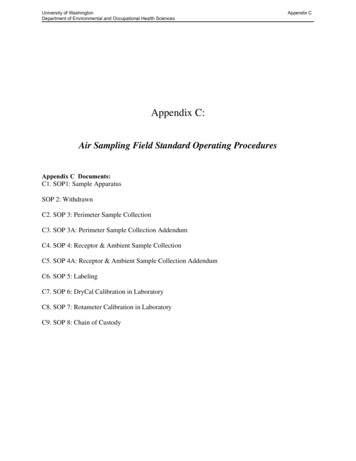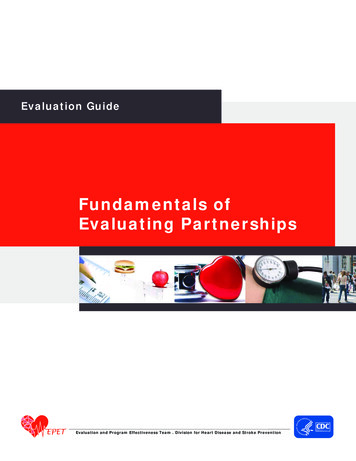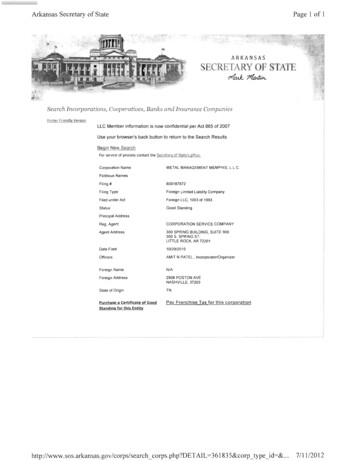
Transcription
University of WashingtonDepartment of Environmental and Occupational Health SciencesAppendix C:Air Sampling Field Standard Operating ProceduresAppendix C Documents:C1. SOP1: Sample ApparatusSOP 2: WithdrawnC2. SOP 3: Perimeter Sample CollectionC3. SOP 3A: Perimeter Sample Collection AddendumC4. SOP 4: Receptor & Ambient Sample CollectionC5. SOP 4A: Receptor & Ambient Sample Collection AddendumC6. SOP 5: LabelingC7. SOP 6: DryCal Calibration in LaboratoryC8. SOP 7: Rotameter Calibration in LaboratoryC9. SOP 8: Chain of CustodyAppendix C
Appendix CPage 1 of 31University of WashingtonDepartment of Environmental and Occupational Health SciencesPilot OP Pesticide Air Monitoring ProjectStandard Operating ProceduresSOP 1: Sampling Apparatus Set-up1.1 ObjectiveThe objective of SOP1: Sampling Apparatus Set-up is to develop an appropriate and consistentmanner to set up the equipment to collect perimeter, receptor, and ambient air samples.Modified from: Ambient Concentrations of Organophosphorus Pesticides Caused byVolatization During Seasonal Pesticide Application, appendix A, attachment 2: samplingprotocol Master’s Thesis. Lisa A. Tolbert 28 May 20071.2 MaterialsSampling mast materials, for each mast Concrete blocks with center hole (8 in x 8 inx 8 in) 4 ft metal stake (not used with locations that are on cement or asphalt) 12 in x 1 in galvanized steel pipe 1.5 in PVC pipes (12 inches long, 2 pieces) 1.5 in PVC pipe (60 inches long) Galvanized steel coupling piece 3 ft x 1 in galvanized steel pipe Hose clamp (small) Hammer Plastic rain gutters ( 24 inches long)Sample Train MaterialsPerimeter OVS XAD-2, quartz filter sorbent tubes(SKC Cat #226-58) Tygon tubing (3/16 in ID, R3603, VWR#63010-042) Tygon tubing (3/8 in ID, R3603, VWR #63010-133) SKC Hi-Lite air sampler (SKC Cat #223-350, 25 L/min capacity) Pipe adaptor 1/8 in NPT to 3/8 inID(Cole-Parmer # 30610-37) Pipe adaptor 1/8 in NPT to 3/16 inID(Cole-Parmer #0 6444-16) Reducing connectors ¼ in to 3/16 in ID(Cole-Parmer # 30622-32) Y-shape connector (3/8 in ID, VWR #62850-106) Sampling masts (9) Rotameters (18) Plastic tubs (9) Zip-tiesAM08 SOP1 SampleApperatus 1Augl081/6Receptor and Ambient OVS XAD-2, quartz filter sorbent tubes (SKC Cat#226-58) Tygon tubing (3/16 in ID, R3603, VWR #63010042) Tygon tubing (1/4 in ID, R3603, VWR #63010064) SKC AirChek samplers (SKC Cat #224-PCXR8,5 L/min capacity) Battery eliminators (SKC Cat # 223-325) Pipe adaptor 1/8 in NPT to 1/4 inID (Cole-Parmer #30610-36)Pipe adaptor 1/8 in NPT to 3/16 inID (Cole-Parmer#06444-16)Reducing connectors ¼ in to 3/16 in ID (ColeParmer #30622-32)Sampling masts (5, four in receptor and one inambient)Rotameters (10, eight in receptor and 2 in ambient)Plastic tubs (5)Zip-ties
University of WashingtonDepartment of Environmental and Occupational Health Sciences Bricks (2/tub)Power Source MaterialsPerimeter Generators Plastic tubs, extra large size Heavy-duty chains Gas cans Plywood platforms Metal stakes Aluminum wiring Padlocks Extension cords BricksAppendix CPage 2 of 31 Bricks (2/tub) Receptor and AmbientMarine deep-cycle batteriesPlastic battery caseVelcroBricksScissorsExtension cordsRotameters PTFE thread seal tape (1/2 in wide) Flowmeters range 1-10 Lpm (Dywer, VRB #66-SSV) Flowmeters range 1-20 Lpm (Dywer, VRB #67-SSV) Flowmeters range 1-10 Lpm (Key Instruments, Item # FR4A41SVVT)1.3 Preparation1.3.1 Sampling mast Construct a T-shape using the PVC pipes. The 60 in long pipe serves as the support stand(upright) while the two 12 in long pipes will be the cross-arm. Attach the rain gutter over the cross arm. Drill two small holes on the bottom of the cross arm at each end.1.3.2 Plastic tubs Drill four holes (2 on each side) toward the top of the plastic tubs; these will serve as ventholes. For perimeter samplingo Place 2 bricks in the bottom of each tub For receptor/ambient samplingo Cut strips of Velcro, attach two sticky strips one side against the inside wall of thetubs and attach the fuzzy strips on the back of the SKC AirChek sampler.o Stick the SKC AirChek samplers to the inside wall of the tubs.o Set two bricks inside the tub, the SKC AirChek sit on top of the bricks.1.3.3 Rotameters Use the PTFE thread seal tape to wrap around the pipe adaptors’ thread. Do not cover theends. For all pipe adaptors, twist the Pipe adaptor 1/8 in NPT to 3/16 inID to the rotameteroutlet (bottom of rotameter). For perimeter samplingAM08 SOP1 SampleApperatus 1Augl082/6
University of WashingtonDepartment of Environmental and Occupational Health Sciences Appendix CPage 3 of 31o Twist the Pipe adaptor 1/8 in NPT to 3/8 inID to the rotameter inlet (top ofrotameter).For receptor/ambient samplingo Twist the Pipe adaptor 1/8 in NPT to 1/4 inID to the rotameter inlet (top ofrotameter).1.4 Sampling mast set-up (at site) Place the concrete block on level ground. Insert 4 ft metal stake into block and hammer about 1 foot into the ground. Insert the 12 in x 1 in galvanized steel pipe into the concrete block (goes over the stake). Attach the galvanized steel coupling piece to the 12 in x 1 in galvanized steel pipe. Place the 3 ft galvanized steel pipe over the 12 in steel pipe. This sits on top of thecoupling piece. Make a 6 in cut parallel cut at the bottom of the PVC pipe with saw. Place the T-shape PVC pipe mast over the 12 in steel pipe. Secure the bottom of 60 inch PVC pipe to the 12 in steel pipe with a small hose clamp.Figure 1: Sampling mast set-up with sampling train1.5 Sampling train set-up1.5.1 Perimeter Place the SKC Hi-Lite air sampler on the ground inside the plastic tub. Pass the extension cord through the vent holes. Connect the sampler’s power plug to the extension cord. Attach the 3/8 in ID Tygon tubing to Hi-Lite sampling pump inlet. Attach the Y-shape connector to the 3/8 in tubing.AM08 SOP1 SampleApperatus 1Augl083/6
Appendix CPage 4 of 31University of WashingtonDepartment of Environmental and Occupational Health Sciences Connect each end of the Y-shape connector to the 3/8 in tubing (split sampling).Attach 3/8 in tubing to the inlet of the rotameter.Attach 3/16 in tubing to the outlet of the rotameter.Connect the 3/16 in tubing to the ¼ in tubing using the reducing connector.Pass the ¼ in tubing through the vent holes on the bottom of the cross-arm.Connect the sampling tube to the 1/4 in tubing once sampling starts.Position the sampling tube at a 90 degree angle inside the cross arm, one tube at eachend.Figure 2: Perimeter Sampling Apparatus with Sampling Train0.6 mSupport StandRain gutterOVS XAD-2 tubesRotameters2mCross ArmTubingPumpPlastic tubGround1.5.2 Receptor/ambient Place two SKC AirChek samplers inside the tub and on top of the bricks. Secure the samplers by attaching them to the Velcro strips along one tub wall. Pass the extension cord through the vent holes. Connect the sampler’s power plug to the extension cord. Attach the 1/4 in ID Tygon tubing to the SKC sampling pump inlets. Pass the 1/4 in tubing through the vent holes. Attach 1/4 in tubing to the inlet of the rotameter. Attach 3/16 in tubing to the outlet of the rotameter. Connect the 3/16 in tubing to the ¼ in tubing by using the reducing connector. Pass the ¼ in tubing through the vent holes on the bottom of the cross-arms. Connect the sampling tube to the 1/4 in tubing once sampling starts. Position the sampling tube at a 90 degree angle inside the cross arm, one tube at eachend.AM08 SOP1 SampleApperatus 1Augl084/6
Appendix CPage 5 of 31University of WashingtonDepartment of Environmental and Occupational Health SciencesFigure 3: Receptor and Ambient Sampling Apparatus with Sampling Train0.6 mSupport StandRain gutterOVS XAD-2 tubesRotameters2mCross ArmTubingPlastic tubPumpsGround1.6 Power source1.6.1 PerimeterTwo generators will supply the AC power source to the 9 SKC Hi-Lite air samplers. The sitelayout will determine the locations of the generators. Use different lengths of extension cords toconnect the generators to the air samplers. Cut vent flaps (rectangle shape) on the shorter sides of the plastic tubs. Select an area where the ground is leveled. Lay the plywood on the ground. Place the generator on top of the plywood. Place the plastic tub over the generator. The generator’s exhaust must be near oneopened flap. Use stakes, brick, and aluminum wiring to hold the tub. Use the chains and locks to secure the generators to a tree or wooden pole.AM08 SOP1 SampleApperatus 1Augl085/6
University of WashingtonDepartment of Environmental and Occupational Health SciencesAppendix CPage 6 of 31Figure 4: Perimeter Generator cover1.6.2 Receptor/ambientUse either AC power or marine deep-cycle batteries for power. This depends on the availabilityand security of an AC power source. AC power sourceso Connect SKC Airchek samplers with extension cords.o Protect cords from foot or vehicle traffic with barriers, covers, or other methods asappropriate to the site. Marine deep-cycle batterieso Store the marine deep-cycle batteries in secure locked battery cases.o Set fully-charged batteries before the start of the sampling period.o Keep detailed records to know when the battery is running low and must be replacedwith another fully-charged battery.AM08 SOP1 SampleApperatus 1Augl086/6
University of Washington, DEOHSSOP 3: Perimeter Sample CollectionAppendix CPage 7 of 31Pilot OP Pesticide Air Monitoring ProjectStandard Operating ProceduresSOP 3: Perimeter Sample Air Collection3.1 ObjectiveTo develop an appropriate and consistent manner to collect perimeter air samples.Modified from: Ambient Concentrations of Organophosphorus Pesticides Caused byVolatilization During Seasonal Pesticide Application, appendix A, attachment 2: samplingprotocol Master’s Thesis. Lisa A. Tolbert 28 May 2007.Referenced SOPS for the OP Pesticide Air Monitoring ProjectSOP 1 Sampling Apparatus Set-upSOP 5 Labeling3.2 MaterialsSampling collection- daily OVS XAD-2, quartz filter sorbent tubes (SKC Cat # 226-58) (2-tubes/location within thesite) Nitrile gloves Perimeter Field Data Sheet Pens - permanent Clipboard Small Ziplock bag sandwichor snack size (1/sample) large Ziplock bag quartz size (1/sample period) Clear packing tape Aluminum foil shields (pre-cut into squares) Screwdriver for sampling pump Field spikes (See Section 3.5 Sampling Plan) Field blanks (See Section 3.5 Sampling Plan) Lab diapers Handiwipes Cooler Blue ice Watch3.3 Preparation3.3.1 Sampling train Set up sampling apparatus according to SOP 1 Sampling Apparatus Set-up3.3.2 Pre-labeling Ziplock bags. Label a quart Ziplock bag with sample start date and sample period. Label eighteen small Ziplock bags with the location numbers. (This is for organizing thesampling tubes.) Label small Ziplock bag per blank with “Field Blank”, sample day (day1, day2, day3,day4, and sample period (morning, lunch, or evening). Label one small bag per spike with Ziplock bag with “Field Spike” sample day (day1,day2, day3, day4, and sample period (morning, lunch, or evening).AM08PerSampCollSOP3 22Mar08.doc1/5
University of Washington, DEOHSSOP 3: Perimeter Sample CollectionAppendix CPage 8 of 313.3.3 Sample tubes preparation before going to the field. Write the sample start date on the sample label. Write the sample start date on the field blank label Write the sample start date on the field spike label. Write the sample start date and location numbers (2 sample tubes for each location on)labels. (Note: Pull up the ends of the sample labels you are preparing to make it easier topeel and stick on the sample tubes.) Pre-cut packaging tape to fit over the sample labels. Layout lap diaper. Open the sample tubes envelopes and gently place the number of tubes required for thesample period on the lab diaper. Put on nitrile gloves. For each sample tube- Place the sample label on sample tube.- Put one packaging tape strip over the sample tube label and place the tube in itscorresponding bag, by site number, small Ziplock bag.- Follow the same steps for the remaining tubes. For the field spike,- Wear nitrile gloves.- Remove the spike from the freezer.- Record the lab label already on the field spike onto the data sheet.- Remove the spike from its Ziplock bag.- Place the field spike label on the tube.- Place packaging tape over the label and replace tube back in its Ziplock bag.- Place the sample tube Ziplock bag in the quart size Ziplock bag that will contain alltubes collected for that sampling day and period. Put duplicate sample labels on the Perimeter Field Data Sheet filling in the start date andthe location numbers. Record sample tube lot number (found on the tube envelop) on the Perimeter Field DataSheet.3.4 Sample collection3.4.1 Set up sample collection area Lay out lab diaper. Designate a clean (new sample) and dirty (old sample) area. Lay out supplies and nitrile gloves.3.4.1 Sample take down - Removing previous day’s sample tubes Record rotameter reading on Perimeter Field Data Sheet. Turn off pump. Record stop date and time on Perimeter Field Data Sheet. Don nitrile gloves. Remove aluminum foil shield from sampling tube. Remove sample tube from tubing (only handle the tube with clean nitrile gloves). Put caps on the tube. Place each tube in a small Ziplockk bag and seal bag.AM08PerSampCollSOP3 22Mar08.doc2/5
University of Washington, DEOHSSOP 3: Perimeter Sample CollectionAppendix CPage 9 of 31 Place all tubes in the quart Ziplockk bag label for the region, sample day, and sampling period.Place the labeled bags in a cooler filled with blue ice for transport back to field officefreezer.3.4.2 Sample set-up: starting sample tubes for the next sampling period Check all tubing and rotameter connections to ensure they are tight. Put on nitrile gloves. Remove prelabeled sample tubes from small Ziplockk bags. For each sampling tube- Remove the thinner end cap and store cap in Ziplock bag.- Connect the thinner end of the tube to the 1/4” tubing attaching it to the rotameter.- Wrap tubes with aluminum foil so that no sampling media is visible. Leave the tubeinlets unobstructed.- Angle the sampling tube downward.- Hold sampling tube in place with duct tape. Check that tubing is securely fastened to the sampling stand. Record on Perimeter Field Data Sheet- Pump number- Rotameter number Turn pump on. Record start time. Adjust flow rate to setting indicated on rotameters (6 liters per minute)- Verify rotameter valves are open (turn counter clockwise).- Use pump screwdriver to turn flow screw on pump.- Adjust flow so that one rotameter is at the designated flow rate and the other ishigher.- Turn (clockwise) the rotameter valve with the higher flow rate until flow ratedecreases and both are within /- 0.2 lpm.NOTE: It may be necessary to go back and forth to adjust both rotameters so thatthey read the designated flow rate. Record final flow rates setting on the Perimeter Sampling Field Data Sheet.3.4.2 Flow rate check Midway through sampling period check flow rates and- Record time and flow rate.- Adjust flowrates to rotameter setting. Record new flowrate.AM08PerSampCollSOP3 22Mar08.doc3/5
Appendix CPage 10 of 31University of Washington, DEOHSSOP 3: Perimeter Sample Collection3.5 Sampling PlanTable 1: Sampling PlanPre-spraySamplinglocations*(including QA)Number ofsample periodsper dayDuration ofSampling periodsNumber of fieldsamples/dayNumber of fieldblanks/dayNumber of fieldspikes/daySampling DaySprayPost-spray 1Post-spray 24 locations colocated QC mast8 locations colocated QC mast8 locations colocated QC mast8 locations colocated QC r3MorningAfternoonNight8-hr10545418162/sampling period62/sampling period62/sampling period62/sampling period22/sampling period62/sampling period124-hr*Each site had 8 locations are situated approximately equidistant from each other around theperimeter of the sampling block. At each location a single sampling mast holds 2 side by sidesamples. The QC sample mast was co-located at one of the eight sampling locations, which held2 side by side samples as well.3.6 Field blanks and spikes. One field blank and one field spike per 10 samples per day.3.6.1 Field blanksField blanks will be treated the same way as the sample tubes. For each sampling period, thefield blank(s) will be started just prior to setting up the sampling tubes at the first location. Tostart the field blank. Don nitrile gloves. Remove sample tube from its pre-labeled Ziplock bag. Remove both end caps. Replace both end caps. Place back in small Ziplock bag. Place small Ziplock bag in the large Ziplock bag for the day/period. Record on data sheet- Time that the field blank(s) were started. Store field blank in the cooler with blue ice.3.6.2 Spikes EH Lab will prepare the field spikes in advance. Store the supply of field spikes inthe field office freezer (-10C). Use nitrile gloves when handling field spikes. Obtain the field spike for the day from -10 C freezer and transport on blue ice. Remove field spike from Ziplockk bag. Label field spike tube with sample label. Replace Place field spike in small Ziplockk bag. Place small Ziplockk bag in the large Ziplockk bag for the day/sampling period. Transport and store field spike in the cooler with blue ice.AM08PerSampCollSOP3 22Mar08.doc4/5
University of Washington, DEOHSSOP 3: Perimeter Sample CollectionAppendix CPage 11 of 31s3.7 Sample tube transport and storage Store all sample tubes, field spikes, and field blanks in ice chest with blue ice in the field Transport all sample tubes, field spikes, and field blanks in ice chest with blue ice to fieldoffice freezer as soon as possible. Store all samples tubes, field spikes, and field blanks in Field freezer (-10C) untiltransport to UW-Fenske lab. Transport all samples tubes; field spikes, and field blanks to UW-Fenske lab in coolerwith dry ice.3.8 Sample labeling See SOP 5: Labeling3.9 Data Storage and Backup Store all Perimeter Field Data Sheets in the offices and in password protected computerresources of R. Fenske at the University of Washington. Scan all data sheets and make PDFs of all data sheets for back up. Store all electronic files on the department server, with password access limited toresearch team staff. The electronic files are backed up daily.AM08PerSampCollSOP3 22Mar08.doc5/5
Appendix CPage 13 of 31University of WashingtonDepartment of Environmental and Occupational Health SciencesPilot OP Pesticide Air MonitoringStandard Operating ProceduresSOP 3A: Perimeter Air Sample CollectionAddendum3A.0 PurposeThe purpose of this addendum is to provide changes in the SOP 3 for phase 2 of the project.3A.1 Sampling Plan – Phase 2Table 1: Sampling Plan – Phase 2. Changes in Bold.Sampling DayPre-spraySprayPost-spray 14 locations co8 locations co8 locations coSamplinglocated QC mastlocated QC mastlocated QC mastlocations(including QA)132Number ofMorningMorningMorningsample periodsAfternoonNightper daySamplingduration/time24-hrNight6-hr spray6-hr after spray12-hr overnight5412-hrPost-spray 28 locations colocated QC mast1Morning24-hr101836Number of fieldsamples/day*1624Number of iodblanks1664Number of iodspikes*Each site had 8 locations are situated approximately equidistant from each other around theperimeter of the sampling block. At each location a single sampling mast accommodates 2 sideby side samples. The QC sample mast was co-located at one of the eight sampling locations.AM08PerSampCollSOP3A 23May08.doc1/1
University of Washington, DEOHSSOP 4: Receptor and Ambient Sample CollectionAppendix CPage 14 of 31Pilot OP Pesticide Air MonitoringStandard Operating ProceduresSOP 4: Receptor & Ambient Sampling Collection4.0 ObjectiveTo develop an appropriate and consistent manner to collect receptor and ambient air samples.Modified from: Ambient Concentrations of Organophosphorus Pesticides Caused byVolatilization During Seasonal Pesticide Application, appendix A, attachment 2: samplingprotocol Master’s Thesis. Lisa A. Tolbert 28 May 2007.Referenced SOPs for the Pilot OP Pesticide Air Monitoring Project areSOP 1: Sampling Apparatus set-upSOP 5: LabelingSOP 7: Rotameter Calibration in Laboratory4.1 MaterialsSample collection - daily SKC Airchek sampler (SKC Cat #224-PCXR8, 5 L/min capacity) with battery eliminator OVS XAD-2, quartz filter sorbent tubes (SKC Cat # 226-58) (2-tubes/day/location) Nitrile gloves Receptor and Ambient Field Data Sheet Permanent pens Clipboard Small Ziploc or similar bag sandwich or snack size (1 /sample) Large Ziploc or similar bag quart size (1/day) Sample labels Clear packaging tape Aluminum foil (pre-cut into squares) Duct tape Screw driver for pump Lab diapers Handiwipes Field spike (1/day) Field blank (1/day) Plastic trash bag Cooler Blue ice WatchAM08RecAmpSampSOP4 March2008kg.doc1/5
University of Washington, DEOHSaSOP 4: Receptor and Ambient SampleCollectioAppendix CPage 15 of 314.2 Preparation4.2.1 Sampling train (prior to first sample start day)Set up sampling apparatus according to SOP 1, including pumps and rotameters.4.2.2 Pre-labeling Ziploc bags. In field office Label a quart size Ziploc bag with today’s date, initials of staff member collecting thesamples, and region. Label three small size Ziploc with the site numbers (this will store the newly labeledsample tubes). Label one small Ziploc as “Field Blank” with date.4.2.3 Sample label preparation. (See SOP 5 for complete description of labels.) In field office Note: For each tube, labels were preprinted in quadruplicate to be used as follows- 1 for sample tube- 1 for Receptor and Ambient Field Data Sheet- 1 for initial chain of custody form- 1 for additional chain of custody form Complete the receptor, ambient, and QC sample labels by writing on the quadruplicatelabels- sample period start date- site number Complete the field spike and field labels by writing on the quadruplicate labels- sample period start date4.2.4 Sample tubes preparation. In field office Pre-cut packaging tape to fit over the sample labels. Place the sample tubes envelopes and gently place the sample tubes on the lab diaper. For each sample tube- Place the sample label on tube. Do not cover any part of the sample id number theunique identifier.- Put packaging tape strip over the sample tube label and place the sample in itscorresponding, small Ziploc bag labeled by site number.- Put matching labels on the data sheet.- Record tube lot number (printed on the tube envelope) on data sheet.- Follow the same steps for the remaining tubes. For the field blank tube- Put field blank label on tube. Do not cover the unique identifier.- Wrap packaging tape strip over the label and small Ziploc .- Put matching label on the Receptor and Ambient Field Data Sheet.- Record tube lot number (on the tube envelop) on Receptor and Ambient Field DataSheet. For the field spike tube- Wear clean nitrile gloves.- Remove the spike tube from the freezer.- Record the lab label already on the field spike onto the data sheet.- Remove the spike from its Ziploc .- Place the field spike label on the tube.AM08RecAmpSampSOP4 March2008kg.doc2/5
University of Washington, DEOHSSOP 4: Receptor and Ambient Sample Collection-Appendix CPage 16 of 31Put matching sample label on the Receptor and Ambient Field Data Sheet.Wrap packaging tape over the label and put tube back in its Ziploc bag.Write the corresponding sample start date on the Ziploc Bag.Place the Ziploc in the quart size Ziploc labeled with the corresponding sample startdate.4.3 Sample collection - In the field4.3.1 Set up sample collection area (applies to both sample start up and sample take down) Lay out lab diaper. Designate a clean (new sample) and dirty (old sample) area. Lay out supplies and nitrile gloves.4.3.2 Sample start-up Put on clean nitrile gloves. Place the two prelabeled sample tubes in clean area. Record on field data sheet.- Pump number- Rotameter number For each sampling tube, follow these steps- Remove the caps and store in Ziploc bag.- Attach narrow end of sample tube to end of 1/4” tubing, letting the tube inlet (wideropening) facing downward.- Check that the tubing is securely fastened to the sampling stand.- Wrap tubes with aluminum foil so that no sampling media is visible. Leave the tubeinlet and outlet unobstructed.- Hold sample tube slanting downward with a piece of duct tape. Do not cover tube inlet- Turn pump on.- Record sample start time. Adjust pump flow rate to setting indicated on rotameter- Verify rotameter valve is open.- Use pump screwdriver to turn flow screw on in-line pump.- Adjust flow 2.0 liters per minute on the rotameter. (Actual flow rate will be calculatedfrom the rotameter calibration curves in SOP 7: Rotameter Calibration in Laboratory.) Wait 5 minutes. Record rotameter reading. Adjust flow rate to setting indicated on rotameter if needed. Record final rotameter setting.4.3.3 Sample Collection- sample take down Record rotameter reading on Receptor and Ambient Field Data Sheet. Turn off pump. Record stop time on Receptor and Ambient Field Data Sheet. Don clean nitrile gloves. Gently tug the tube out of the mast by pushing out the tubing. Remove aluminum foil. Remove sample tube from tubing (only touch the sample tube with clean nitrile gloves –nothing else).AM08RecAmpSampSOP4 March2008kg.doc3/5
University of Washington , DEOHSSOP 4: Receptor and Ambient Sample CollectionAppendix CPage 17 of 31 Put caps on the tube. Push each capped end down on firm surface to secure the cap is secure.Place each tube in a small Ziploc bag.Place all tubes in a large Ziploc bag labeled with the project ID, date, region, andinitials (for example, AMO8Region2 1Feb08kg).Place the labeled bags in a cooler filled with blue ice for transport back to freezer.4.5 Field blanks and Field spikes4.5.1 General One field blank and one spike for each sampling day. Field blanks and field spikes for a given sample period are set-up on the start day for thatsample period. Field blanks and field spikes are taken into the field during the sample start-up for thesame sample period. Store and transport the field blank and field spike in a cooler filled with blue ice duringthe sample period.4.5.2 Field Blanks See section 4.2 for preparation of field blank tubes in the field office. Field blanks are uncapped and recapped the first site for start-up at the beginning of thesampling period. To cap and recap field blank- Don clean nitrile gloves.- Remove sample tube from its pre-labeled Ziploc bag.- Remove both end caps.- Replace both end caps.- Place in small Ziploc bag.- Place small Ziploc bag in the large Ziploc bag for the day.- Record time on Receptor and Ambient Field Data Sheet.4.5.3 Field Spikes Field spikes were prepared by the University of Washington Environmental HealthLaboratory. The supply of field spikes will be stored in the field office freezer. Start the field spike for a given sample period in the field office before going into thefield to start-up the samples. See section 4.2 for preparation of field spikes in field office.4.6 Sample, field blank, and field spike tube transport and storage Transport all sample, field blank, and field spike tubes in cooler filled with blue ice whenin the field. Store samples, field blanks, and spikes in freezer (-10C) until lab analysis. Freezers arelocated at- Yakima field office- Wenatchee field office- Seattle UW-Fenske lab freezers located in F-216 HSB. Transport all tubes from field offices to UW in cooler under dry ice.AM08RecAmpSampSOP4 March2008kg.doc4/5
University of Washington, DEOHSAppendix CPage 18 of 31SOP 4: Receptor and Ambient Sample Collection4.7. Cleanup Every day at each field site pick up all trash and used gloves and put in plastic garbagebag.4.8 Sampling PlanTable 1: Ambient and Receptor Sampling plan.# of sample periods 28 consecutive dayssample period duration 24 hours (1 day)sample typeambientreceptorqca131# sites222# samples/site/periodb262# samples/type/period111# field spikes/period111# field blanks/periodaThe qc sample mast was co-located at on of the receptor sites.bEach site has one sampling mast for each sample site. The sampling mast holds 2 side-by-sidesamples.4.9 Data Storage and Backup Store all Receptor/Ambient Data Sheets in the offices and in password protected computerresources of R. Fenske at the University of Washington. Scan all data sheets and make PDFs of all data sheets for back up. Store all electronic files on the department server, with password access limited to researchteam staff. The electronic files are backed up daily.AM08RecAmpSampSOP4 March2008kg.doc5/5
University of Washington, DEOHSAppendix CPage 19 of 31SOP 4A: Receptor and Ambient Sample Collection AddendumPilot OP Pesticide Air MonitoringStandard Operating ProceduresSOP 4A: Receptor & Ambient Air Sample CollectionAddendum4A.0 PurposeThe purpose of this addendum is to provide changes in the SOP 4 for phase 2 of the project.4A.1 Sampling PlanTable 1: Ambient and Receptor Sampling plan – Phase 2. (changes in italics)# of sample periods 24, sampling every third daysample period duration 24 hours (1 day)sample typeambientreceptorQCa131# sitesb222# samples/site/period262# samples/type/period111# field spikes/period111# field blanks/periodaThe qc sample mast was co-located at on of the receptor sites.bEach site has one sampling mast for each sample site. The sampling mast holds 2 side-by-sidesamples.AM08RecAmpSOP4A May2008kg.doc1/1
University of WashingtonDepartment of Environmental and Occupational Health SciencesAppendix CPage 20 of 31Pilot OP Pesticide Air Monitoring ProjectStandard Operating ProceduresSOP 5: Labelin
Sampling mast materials, for each mast Concrete blocks with center hole (8 in x 8 inx 8 in) 4 ft metal stake (not used with locations that are on cement or asphalt) 12 in x 1 in galvanized steel pipe 1.5 in PVC pipes (12 inches long, 2 pieces) 1.5 in PVC pipe (60 inches long) Galvaniz










